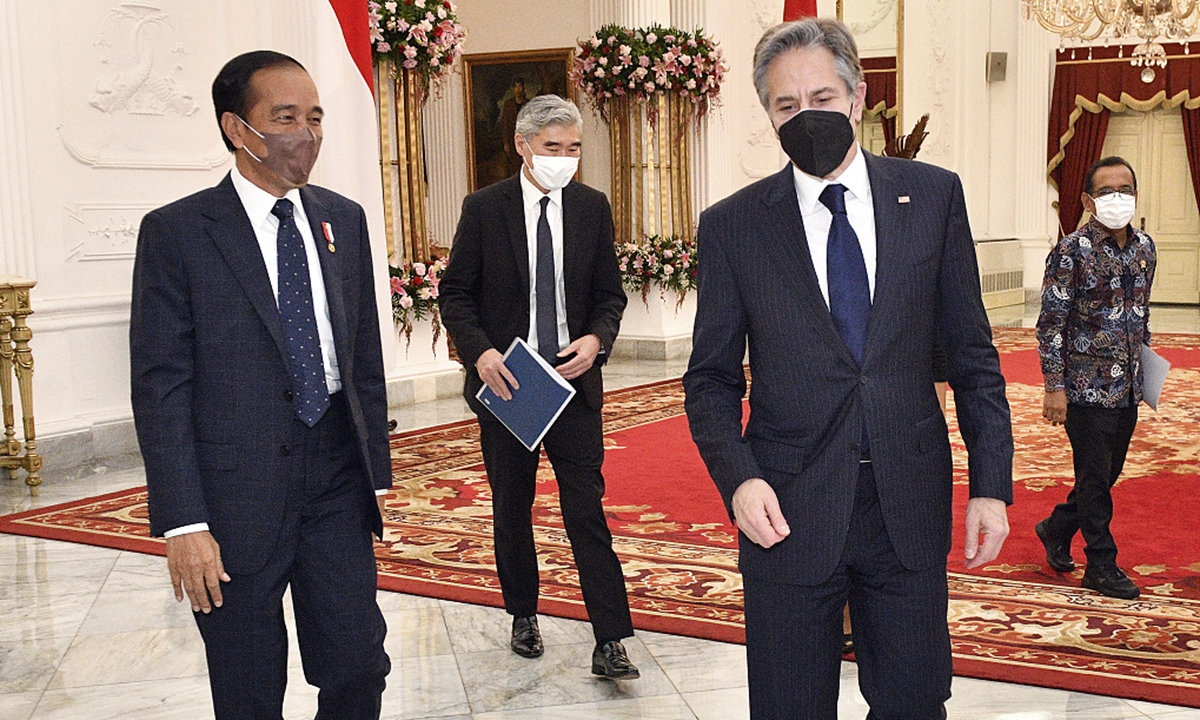
Indonesian President Joko Widodo (left), walks with US Secretary of State Antony Blinken. Photo: VCG
US Secretary of State Antony Blinken kicked off a four-day visit to Southeast Asia as he arrived in Indonesia’s capital Jakarta on Monday. The trip, the first for Blinken since US President Joe Biden took office in January, is aimed at strengthening ties in a region that has become a strategic battleground between Washington and Beijing.
Experts said although Blinken is likely to reach some consensus with the Indonesian government to make preparations for Biden’s future visit, the US would fail to woo neutral regional countries.
Blinken met Indonesian President Joko Widodo on Monday, during which they discussed ways to boost the US-Indonesia relationship, as well as “address challenges to democracy and human rights, as well as the climate crisis and the COVID-19 pandemic,” VOA reported, citing US State Department spokesman Ned Price.
Before the trip, Blinken attended
the two-day G7 foreign ministerial meeting in England, during which he underscored the need to cooperate with the Association of Southeast Asian Nations as well as like-minded nations such as Australia and India.
The next step of the US is probably for Biden to visit Southeast Asia, which aims to show the great importance Biden attaches to the region in contrast to the previous Trump administration, Gu Xiaosong, dean of the ASEAN Research Institute of Hainan Tropical Ocean University, told the Global Times on Monday.
The importance the Biden administration attaches to Southeast Asia shows that the region is vital for promoting its Indo-Pacific strategy, which could only succeed when Southeast Asia is made full use of, Gu explained.
The US Secretary of State will deliver a speech on the US Indo-Pacific strategy on Tuesday, then go to Malaysia and Thailand.
These countries are good at maintaining a balance between China and the US, in terms of neither being wholly dependent on China or the US, which is a characteristic of foreign policies in many countries in the region, Gu said.
So neither Blinken’s visit nor Biden’s possible future trip will fundamentally change the neutrality and equilibrium of Southeast Asian countries for the sake of regional development and policy-making, Gu noted.
ASEAN has surpassed the EU as China's largest trading partner for the first time in 2020. China has been ASEAN's largest trading partner for the last 12 years. This makes it almost impossible for the US to counter China's economic influence in the region, experts said.
“The secretary’s meetings will focus on strengthening the regional security infrastructure in response to PRC [People's Republic of China] bullying in the South China Sea,” Daniel Kritenbrink, assistant secretary of state for East Asian and Pacific affairs, was quoted as saying by media.
In each country, Blinken will also address the worsening crisis in Myanmar and meet with government officials, civil society leaders, business stakeholders, and US embassy personnel, according to the website of the US Department of State.
It is not surprising that Blinken has chosen to focus on issues related to the South China Sea and Myanmar during the visit as it is an old trick of the US to make use of disputes among others to serve its diplomatic and strategic targets. Hyping disputes between China and some Southeast Asian countries is to provoke these countries to stand opposite China and contain China’s development and influence in the region, experts said.
As to the Myanmar issue, which will bother most Southeast Asian countries if not settled, Blinken is sure to touch on it to exert pressure on Myanmar’s government. “After all, the US has a long history of poking its nose at other countries’ internal affairs,” Gu said.




